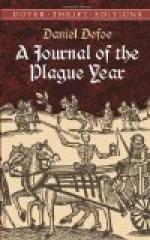The usual number of burials within the bills of mortality for a week was from about 240 or thereabouts to 300. The last was esteemed a pretty high bill; but after this we found the bills successively increasing as follows:—
Buried. Increased. December the 20th to the 27th 291 ... " " 27th " 3rd January 349 58 January the 3rd " 10th " 394 45 " " 10th " 17th " 415 21 " " 17th " 24th " 474 59
This last bill was really frightful, being a higher number than had been known to have been buried in one week since the preceding visitation of 1656.
However, all this went off again, and the weather proving cold, and the frost, which began in December, still continuing very severe even till near the end of February, attended with sharp though moderate winds, the bills decreased again, and the city grew healthy, and everybody began to look upon the danger as good as over; only that still the burials in St Giles’s continued high. From the beginning of April especially they stood at twenty-five each week, till the week from the 18th to the 25th, when there was buried in St Giles’s parish thirty, whereof two of the plague and eight of the spotted-fever, which was looked upon as the same thing; likewise the number that died of the spotted-fever in the whole increased, being eight the week before, and twelve the week above-named.
This alarmed us all again, and terrible apprehensions were among the people, especially the weather being now changed and growing warm, and the summer being at hand. However, the next week there seemed to be some hopes again; the bills were low, the number of the dead in all was but 388, there was none of the plague, and but four of the spotted-fever.
But the following week it returned again, and the distemper was spread into two or three other parishes, viz., St Andrew’s, Holborn; St Clement Danes; and, to the great affliction of the city, one died within the walls, in the parish of St Mary Woolchurch, that is to say, in Bearbinder Lane, near Stocks Market; in all there were nine of the plague and six of the spotted-fever. It was, however, upon inquiry found that this Frenchman who died in Bearbinder Lane was one who, having lived in Long Acre, near the infected houses, had removed for fear of the distemper, not knowing that he was already infected.
This was the beginning of May, yet the weather was temperate, variable, and cool enough, and people had still some hopes. That which encouraged them was that the city was healthy: the whole ninety-seven parishes buried but fifty-four, and we began to hope that, as it was chiefly among the people at that end of the town, it might go no farther; and the rather, because the next week, which was from the 9th of May to the 16th, there died but three, of which not one




